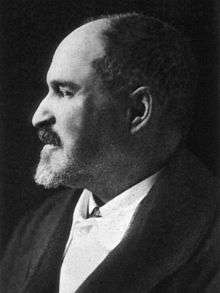Paul Carnot

Paul Carnot (16 November 1869 – 1 June 1957) was a French physician born in Limoges.
He served as médecin des hôpitaux in Paris, becoming a professor of therapeutic medicine in 1918 to the Paris medical faculty. In 1922 he was elected as a member to the Académie de Médecine.[1]
Career
In 1906 he coined the term hémopoïétine (hemopoietin) to define a humoral factor he believed was responsible for regulation of red blood cell production. This being based on experiments with laboratory rabbits that he conducted with his assistant C. DeFlandre. They noticed that an increase of reticulocytes in normal rabbits occurred following the injection of blood plasma taken from anemic donor rabbits who had earlier been subject to bloodletting.[2] Findings from their research were published in a paper titled Sur l'activité hémopoïétique du sérum au cours de la régénération du sang (On the hemopoietic activity of serum during the regeneration of blood).[3]
Carnot was the author of numerous treatises on a wide array of medical subjects. With Paul Brouardel (1837–1906), Augustin Nicolas Gilbert (1858–1927) and others, he published the multi-volume Nouveau traité de médecine et de thérapeutique. The following are a few of his better known writings:
- Les régénerations d'organes, 1899 (Regeneration of organs)
- Maladies microbiennes en général, 1905 (Microbial illnesses in general)
- Médications histopoiétiques et médications histolytiques, 1911 (Medications histopoietic and histolytic)
- Precis de therapeutique, 1925 (Summary of therapy)
- La clinique medicale de l'Hôtel-Dieu et l'oeuvre du Pr Gilbert 1927 (The Medical Clinic of the Hôtel-Dieu and the work of Professor Gilbert)
References
- IDREF.fr (list of publications)
- ↑ Biographies – BIU Santé, Paris
- ↑ Ahmet Höke (2006). Erythropoietin And the Nervous System: Novel Therapeutic Options for Neuroprotection. Birkhäuser. pp. 2–. ISBN 978-0-387-30010-8. Retrieved 23 April 2012.
- ↑ L'érythropoïétine et la fonction hémopoiëtique du rein